1964 CHEVROLET CORVETTE engine
[x] Cancel search: enginePage 5 of 52
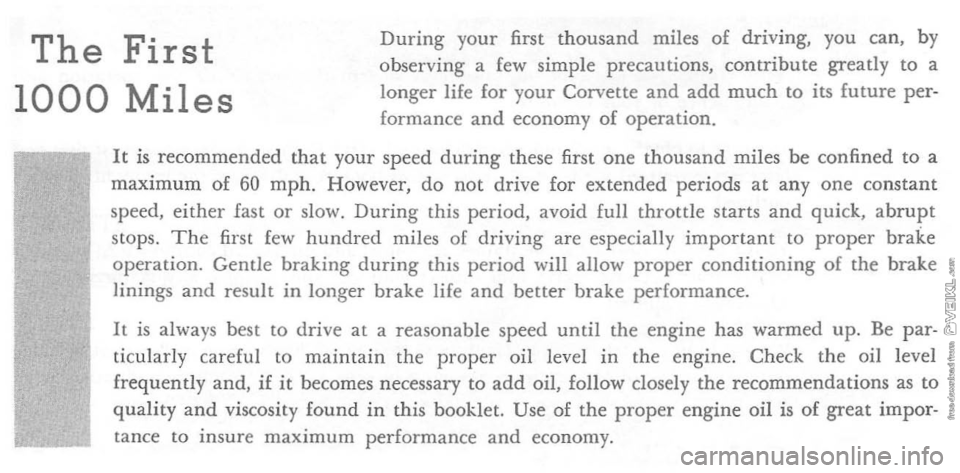
The First
1000 Miles
During your first thousand miles of driving, you can, by
observing a few simple precautions. contribute greatly to a
longer life for your Corvette
and add much to its future per
formance and economy of operation.
It
is recommended that your speed during these first one thousand miles be confined to a maximum of 60 mph. However, do not drive for extended periods at anyone constant
speed, either fast or slow. During this period, avoid full throttle starts and quick, abrupt stops. The first few hundred miles of driving are especially important to proper brake
operation. Gentle braking during this period will allow proper conditioning of the brake
linings and result in longer brake life and better brake performance.
It
is always best to drive at a reasonable speed until the engine has warmed up. Be particularly careful to maintain the proper oil level in the engine. Check the oil level
fre quently and, if it becomes necessary to add oil, follow closely the recommendations as to
quality and viscosity found in this booklet. Use of the proper engine oil is of great impor
tance to insure maximum performance and economy.
Page 7 of 52

Starting the Engine
IGNITION SWITCH
•
The five-position ignition switch allows full control of the electrical systems of your Corvette. To start engine turn the switch to START and release as soon as the engine starts. The switch will r eturn to the ON position and all electrical circuits will be ready for use. Use OFF, LOCK and ACC positio ns to stop the engi ne. The ACC position will anow you to use all accessories without e n ergizi ng the ignition system.
NOTE, /(ey cannot
be ,emoved from the ignition ..... itch . ';f;;;.#fi';;'..;;a.;:" i;h~'i4i;C't:;o:N:' accidentally leaving IWifeh OFF but IlOl ladeed. /(fl' 111(" b. nollllOVed 11 position and the switch may be moved between
STARTING
PROCEDURES
Place the transmission selector lever in neutral or park position and, on manual transmission equipped models, push the clutch pedal down while starting engine.
Depress the accelerator pedal to the floor and fully release. Turn the ignition switch to START and hold until the engine starts. During temperatures of 0 ° F, and below, and when the engine is hot, the acce lerator pedal should be held part way down while starting. Start a "flooded" engine by holding accelerator pedal to the floor while o'anking engine. CAUTION: Carbon monoxide is a poisonous gas produced by the engine of any ca?'. It is odorless
so you cannot detect its presence. B e safe. Never Sial"t or run YOW" C01"Velte in a closed garage or park with the windows closed and engine operating.
Page 8 of 52
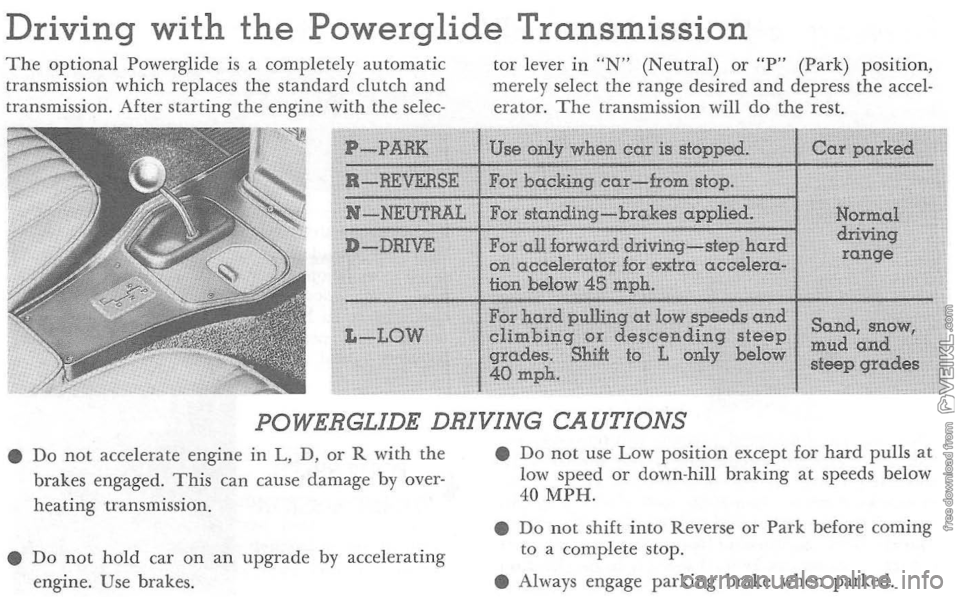
Driving with the Powerg lide Transmission
The optional Powerglide is a completely automatic transmission which replaces the standard clutch and transmission. After starting the engine with the seIce-
P-PARK R-REVERSE N-NEUTRAL
D - DRIVE
L-LOW
tor !ever in "N" (Neutral) or "P" (Park) position, merely select the range desired and depress the accelerator. The transmission will do the rest.
Use only
when car is stopped. Car parked
For backing car-from stop.
For
standing-brakes applied. Normal
For
all forward driving -step hard driving
on
accelerator for extra accelera-range
lion below 45 mph.
For
hard pulling at low speeds and Sand, snow, climbing or descending sleep mud and grades. Shift to L
only
below
steep grades 40 mph. ~I_, ~
POWERGLIDE DRIVING CAUTIONS
• Do not accelerate engine in L, D , or R with the brakes engaged. This can cause damage by overheating transmission.
•
Do not hold car on an upgrade by accelerating engine. Use brakes. •
Do not use Low position except for hard pulls at low
speed or down-hill braking at speeds below
40 MPH.
• Do not shift inw Reverse or Park before coming to a complete stop .
• Always engage
parking brake when parked.
I
J
Page 9 of 52
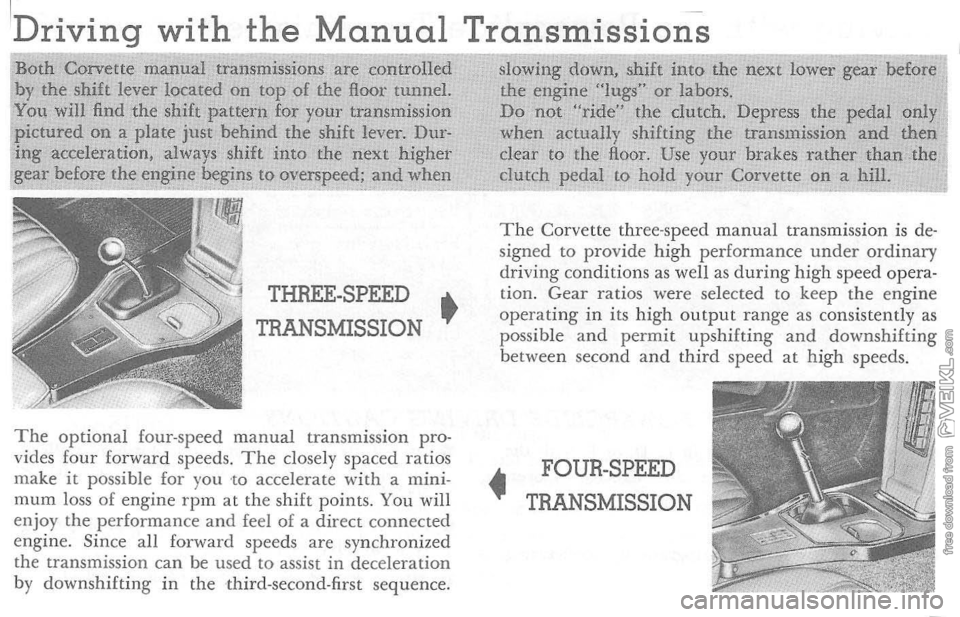
IDriving with the Manual Transmission-s
Both Corvette
manual transmissions are controlled slowing down, shift into the next lower gear before
by the shift lever located on top of the Hoor tunnel. the engine
"lugs" or labors.
You will find the shift pattern for your transmission Do not "ride" the dutch. Depress the pedal only pictured on a plate just behind the shift lever. Dur- when actually shifting the transmission and then ing acceleration, always shift into the next higher clear to the Hoar. Use your brakes rather than the
gear before the engine
begins to oVeISeeed; and ,;h_e_n~ __ cl_u_ tch_ pedal to hold your Corvette on a hill.
THREE-SPEED •
TRANSMISSION
The optional fouf4speed manual transmISSIOn provides four forward speeds. The closely spaced ratios
make it possible for you to accelerate with a mini
mum loss of engine rpm at the shift points. You will
en joy the performance and feel of a direct connecte d
engi ne. Since all forward speeds afe synchronized
the transmission can be used to assist in deceleration
by downshifting in the third-second-first sequence.
The Corvette three-speed manual transmission is designed to provide high performance under ordinary
driving conditions as well as during high speed opera
tion. Gear ratios were selected to keep the engine
operating in its high output range as consistently as possible and permit upshifting and downshifting
between second and third speed at high speeds.
• FOUR-SPEED
TRANSMISSION
Page 10 of 52
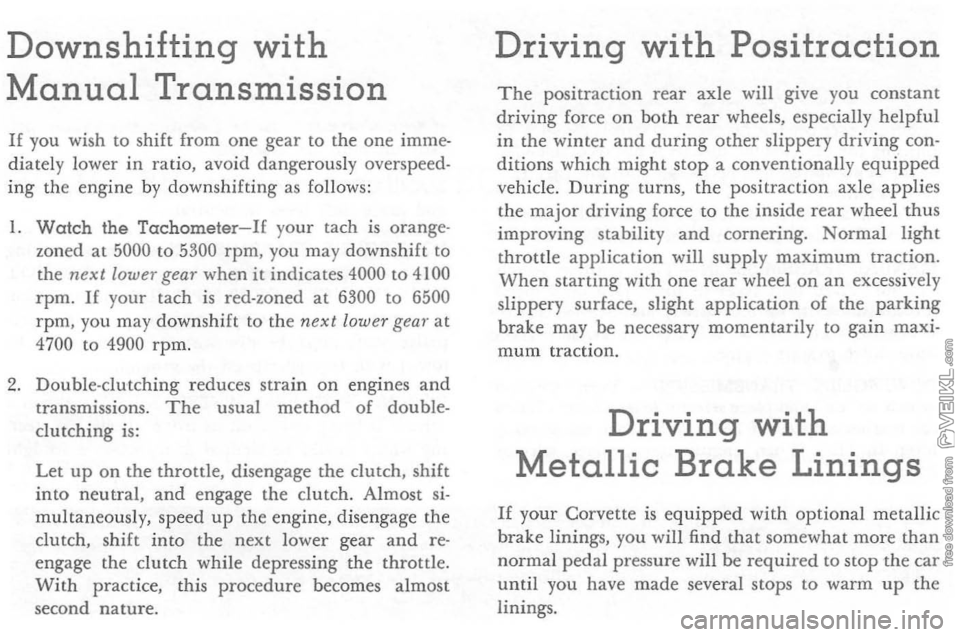
Downshifting with
Manual Transmission
If you wish to shift from one gear to the one imme
di ately lower in ratio, avoid dangerous ly overspeed
ing the engine by downshifting as follows:
I.
Watch the Tachometer-If your tach is orange
zoned at 5000 to 5300 rpm, you may downshift to
the next lower gear when it indicates 4000 to 4100
rpm. If your tach is red-zoned at 6300 to 6500 rpm, you may downshift to the next lower gear at 4700 to 4900 rpm.
2. Double-clutching reduces strain on engines and transmissions. The usual method of double
clutching is:
Let up on the throttle, disengage the clutch, shift
into neutral, and engage the clutch. Almost simultaneously, speed up the engine, disengage the
clutch, shift into the next lower gear and reengage the clutch while depressing the throttle.
With practice , this procedure becomes alm ost
second nature.
Driving with Positraction
The positraction rear axle will give you constant
driving force on both rear wheels, especially helpful in the winter and during other slippery driving con
ditions which might stop a conventionally equipped vehicle. During turns , the positraction axle applies
the major driving force to the inside rear wheel thus
improving stability and cornering. Normal light throttle application will supply maximum traction.
When starting with one rear wheel on an excessive ly
slippery surface, slight application of the
parking brake may be necessary momentarily to gai n maxi
mum traction.
Driving with
Metallic Brake Linings
If your Corvette is equipped with optional metallic
brake linings, you will find that somewhat mor e than
normal pedal pressure will be required to stop the car
until you have made several stops to warm up the
linings .
Page 11 of 52
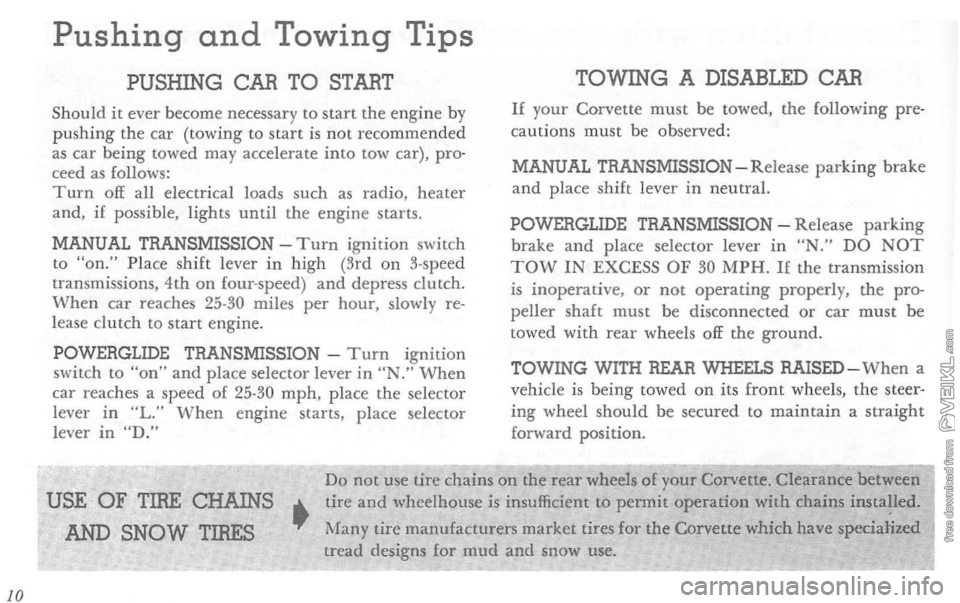
10
Pushing and Towing Tips
PUSHING CAR TO START
Should it ever beco me necessary to start the engine by
pu shing the car (towing to start is not recommended as car being towed may accelerate into tow car), pro
ceed as fo llows: Turn off all e lect rical loads su ch as radio, heater
and, if possible, lights until the engine st arts.
MANUAL TRANSMISSION - T
urn ignition switch
to "on." Place shift leve r in high (3rd on 3-spee d
transmissions, 4th on four-speed) and depress clutch. When car reaches 25-30 miles per hour, slowly re
l ease clutch to sta rt e ng ine.
POWERGLlDE TRANSMISSION -
Turn ignit io n
switch to "on" and place sel ector lever in "N." W h e n
car reac hes a spee d of 25-30 mph, place th e selecto r
l ever in
A DISABLED CAR
If your Corvette must be towed, the following pre
cautions must be observed:
MANUAL TRANSMISSION
-Release parking brake
and place shift lever in neutral.
POWERGLIDE TRANSMISSION -Release
parking brake and place selector lever in "N." DO NOT TOW IN EXCESS OF 30 MPH. II the transmission is inoperative, or not operating properly, the propeller shaft must b e d isconnected or car must be
towe d with rear wheels off the ground.
TOWING WITH REAR WHEELS
RAISED-When a
vehicle is being towed on its front wheels, the steer
ing whee l shou ld be secured to maintain a straight
forward position.
Do
not use tire chains on the rear wheels of your Corvette . Clearance between
USE OF TIRE CHAINS
AND SNOW TIRES
• tire and wheelhouse is insufficient to permit operation with chains insta!led.
Many [ire manufa cturers market tires for the Corvette which have specialized
tread designs for mud and snow use.
Page 14 of 52
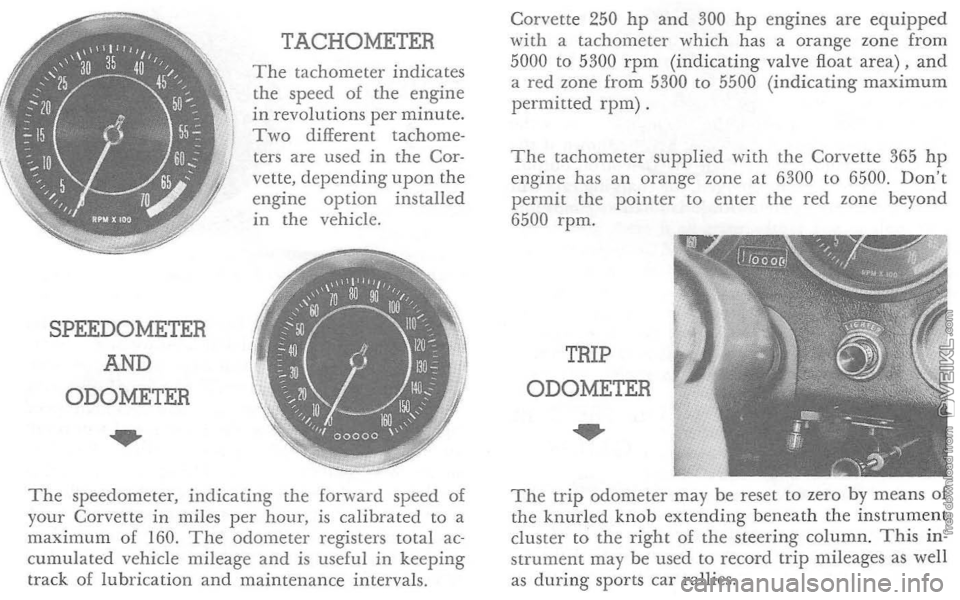
SPEEDOMETER
AND
ODOMETER
..
TACHOMETER
The tachometer indicates
the speed of the engine in revolutions per minute. Two different tachometers are used in the Cor
vette, depending upon the engine option installed
in the vehicle.
The speedometer, indicating the forward speed of
your Corvette in miles per hour, is calibrated to a
maximum of 160. The odometer registers total accumulated vehicle mileage and is useful in keeping
track of lubrication and maintenance intervals. Corvette
250
hp and 300 hp engines are equipped with a tachometer which has a orange zone from
5000 to 5300 rpm (indicating valve float area) , and a red zone from 5300 to 5500 (indicating maximum permitted rpm) .
The tachometer supplied with the Corvette 365 hp engine has an orange zone at 6300 to 6500. Don't permit the pointer to enter the red zone beyond
6500 rpm.
TRIP
ODOMETER
The trip odometer may be reset to zero by means of
the knurled knob extending beneath the instrument
cluster to the right of the steering column.
This in
strument may be used to record trip mileages as well as during sports car rallies.
Page 15 of 52
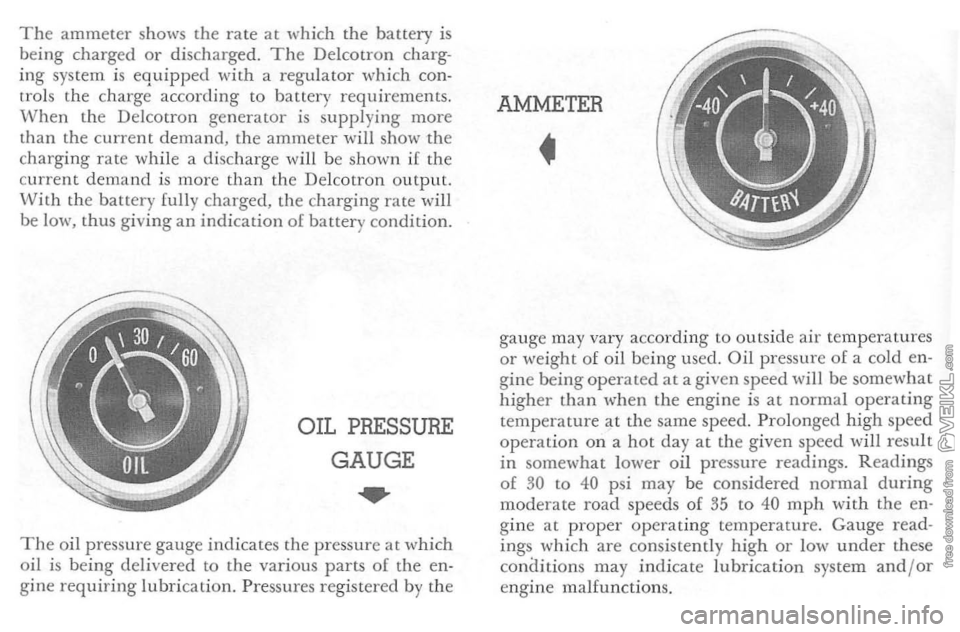
The ammeter shows the rate at which the battery is being charged or discharged. The Delcotron charg
ing system is equipped 'with a regulator which con
trol s the charge acco rding to battery requirements.
When the Delcotron generator is supp lying more
than the curre nt demand, the ammeter will show the
chargi ng rate while a disc harg e will be shown if
the
current demand is more than the Delcotron output.
With the battery fully charged , the charging rate will be 1m-\', thus giving an indication of battery condition.
OIL PRESSURE
GAUGE
...
The oil pressure gauge indicates the pressure at which
oil is being delivered to the various parts of the en·
gine requiring lubrication. Pressures registered by the
AMMETER
•
gauge
may vary acco rding to outside air temperatures or weight of oil being used. Oil pressure of a cold en
gine being operated at a given speed will be somewhat
higher than when the engine is at normal operating
temperature at the sam e speed. Prolonged high speed operation on a hot day at the giv en speed will result in somewhat lower oil pressure readings. Readings of 30 to 40 psi may be considered normal during moderate road speeds of 35 to 40 mph with the en
gine at proper operating temperature. Gauge read
in gs whi ch are consistently high or low under these
co nCIitions may ind i cate lubrication system and/or
engine malfunctions.